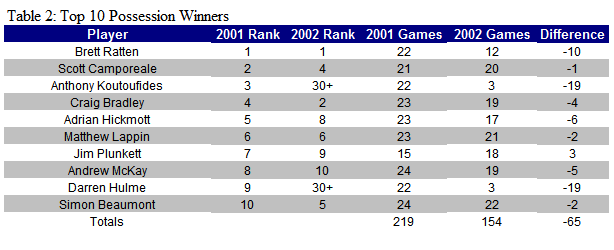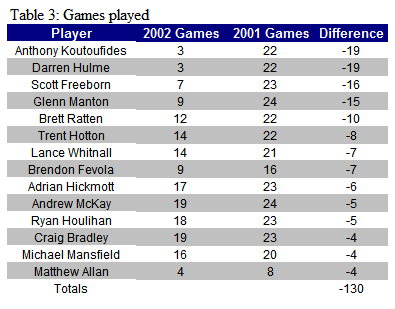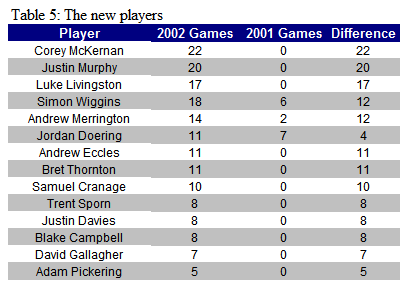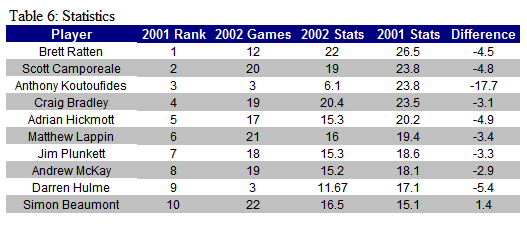But first, a little background. The difference in returns for Carlton between 2001 and 2002 was astounding – dropping from 14 wins to 3 wins, and losing a massive 50% off our percentage:

Many fans talk about the injuries Carlton suffered in 2002 as the key driver to this horrible slide down the slippery slope. No doubt, there is evidence to support this. An analysis of how Carlton’s top 10 possession winners from 2001 went in Season 2002 makes for a sombre read:

A total of 65 games were lost from this grouping of players from 2001 to 2002, most notably from 3 key players – Brett Ratten, Anthony Koutoufides and Darren Hulme. Considering one of the major attributes of each of these players is earning the contested ball provides an interesting perspective on 2002 which we shall explore later. It appears as though Carlton had a glorious run of availability of key players in 2001, with only Jim Plunkett falling under 20 games, which had more to do with team balance and selection than injuries. It would all change in 2002 – with only one player in Simon Beaumont managing to play all games for the year. All other high possession winners suffered from injury at some point in 2002, some more so than others.
The damage caused by injury goes further than the ‘Top 10 Possession Winners’ utilised in Table 2.

These 14 players played 130 less games in 2002 than they did in 2001 – an average of about 6 players missing each game. The list itself lends weight to the argument that injuries across the playing list were a problem, requiring top-up players or young players who may not have been ready to stand up. Key players Allan, Koutoufides, Bradley, McKay, Hickmott, Whitnall, Freeborn and Hulme missed 92 potential games over the year between them - over 11 each on average.
Besides injuries, there were a few other notable absentees:

The retirements of Stephen Silvagni and Dean Rice created holes across our new, young, defence, whilst Mark Porter and Kris Massie were by now at other Clubs.
There is therefore no doubt that the 2002 playing list was suffering from key retirements and a spate of injuries across not only the top possession winners from the previous year, but across the entire list itself. In order to keep our ground, or at least minimise the effect of these losses, young players and new recruits would have to be given a chance in Season 2002. And they were – in droves:

These 14 players would be given a number of opportunities to fill the breach in Season 2002, amassing 162 games between them or an average of 11.6 each. Most notable are the trade-ins of McKernan and Murphy, who would have a positive impact in this year, with McKernan winning the Best & Fairest. Also of note are three of Carlton’s 2000 Drafting campaign – Livingston, Sporn and Wiggins. However, it is important to note that only 2 of the above 14 players are still playing AFL – Wiggins and Thornton.
It is this list of incoming players that provides another interesting aspect to the ‘great slide’ – put simply, our replacements were not up to the task. Good teams have the ability to cover injuries, to a point, but Carlton circa 2002 could not. After years of failing with draft picks, or trading them away, we simply did not have the back-up available to compete effectively. After all, you’re only as good as you’re weakest link…
Consider that in 2002, draftees from the 1997, 1998 and 1999 drafts should have been emerging as players – Carlton had the 2000 draftees fighting for positions, and had even given Thornton and Davies (taken from more recent drafts) a crack at the seniors. But not one player drafted with Pick 60 or less from the 1997 and 1999 drafts was still with Carlton, with Massie, Chatfield and Black gone – and of course all three of our early picks in 1999 were handed away for Mansfield and Stephen O’Reilly. Further, only Fevola and Prendergast remained from the 1998 draft, but both were struck down by injury and poor form in 2002. Instead, the incoming players were an assorted selection of late draft picks, rookies and last-minute trades, which surely provide a lesser chance in success.
If the above view is correct, and the lack of longevity in the game by those in Table 5 suggests that it is, then it is feasible that the lower quality of players coming in would also impact on the team as a whole. Consider the 2001 Top 10 Possession Winners again:

As indicated earlier, Ratten, Koutoufides and Hulme are natural contested ballwinners, and each had an injury-riddled 2002. But each of the other players, with the exception of Simon Beaumont (whose statistics went up probably because of an increase in time the ball spent in our defensive 50), had a material fall in their playing stats. Outside midfielders Camporeale and Bradley suffered significantly, potentially due to a fall in output from the loss of three players mentioned above. Add the courage of Hickmott to the sidelines and the overall ‘grunt’ of the team was disappearing.
Indeed, Carlton faced a significant injury list in 2002 across both the star players of previous years and the list in general. When it came to covering the loss of such players, Carlton struggled due to a lack of success in recruiting long-term players to the Club from (at least) 1997 onwards – and in fact exacerbated the problem by trading early picks for players who would only provide short-term cover. In some respects, the Horrible Slide of 2002 may provide positive long-term benefits to the Club in that it may have destroyed, once & for all, the strategy of trading away of such picks. And now, in Season 2006, the Blues appear to have finally adopted the recruiting plans other Clubs have followed for quite some time.
